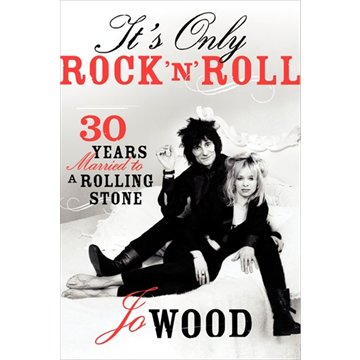
Books about celebrities written by former spouses, especially former spouses who were unceremoniously dumped after three decades, need to be read with a wary eye. However, in her new memoir It’s Only Rock n Roll: Thirty Years Married to a Rolling Stone, Ronnie Wood’s ex-wife Jo Wood offers what seems to be a pretty honest account of life with the Rolling Stones lead guitarist.
The book begins with an account of Wood’s life before meeting Ronnie in her early 20s, including some interesting tales of her experiences as an international model and stalwart of England’s fashion scene in the 1970s, but of course that is mere prelude to the stuff everyone cares about – life with her famous husband and his even more famous bandmates.
Ronnie comes across in Wood’s first meeting with him at an A-list party in 1977 as charming, drunk and befuddled, and these qualities proved to be defining across the next three decades the two spent together. Wood was already divorced with a small child when she met Ronnie, also a father of a small child who was technically still married to his first wife Krissy but basically living apart from her due to her long-term affair with Led Zeppelin guitarist Jimmy Page. Wood and Ronnie were instantly smitten, she was pregnant within a few months of their first date, and he had filed for divorce and moved in with her full-time in less than a year.
Wood’s affection for Ronnie and for the Rolling Stones is evident throughout the book, but she does not pull any punches in describing the crazy world of sex, drugs and rock n roll she entered. While Wood was hardly a novice partier when she met Ronnie, her description of his continual intake of alcohol, cocaine and pills throughout their 30 years of cohabitation (they did not get married until 1985) makes him sound like he was potentially an even bigger drug user than his bandmate and best friend Keith Richards. While Ronnie is not described as ever getting seriously involved with heroin the way Richards did, it is interesting that Richards refused to join Ronnie in his freebasing habit that spanned much of the 1980s and left the Woods basically bankrupt by the time he finally gave it up.
Wood seems to be especially fond of Richards, who remains her close friend, despite the fact he was shooting up the first time she met him, had a habit of occasionally pulling a gun or knife on people who annoyed him and had no hesitation in openly using drugs during Sunday dinners at her home that included her parents. Mick Jagger is described as charismatic and witty but also distant and businesslike, while Bill Wyman and Charlie Watts are nice blokes who mostly lurked in the background. Her portraits of the key members of the Rolling Stones more or less echo the portraits drawn by Richards in his 2011 autobiography “Life,” including his self-portrait.
Like many addicts, Ronnie Wood was creatively gifted and could be quite charming and affectionate when sober, which made his ex-wife willing to tolerate the meanness and self-absorption he displayed when drunk or high. The periods of intoxication and bad behavior grew longer and more intense as the years went on, with even longtime Rolling Stones sidekick and noted degenerate Freddie Sessler eventually noticing how badly Jo was getting treated. Ronnie’s appetite for young groupies also intensified over the years, until he finally left Jo for a Ukranian cocktail waitress more than 40 years his junior in 2009.
Everything ends relatively happy, though. Wood does not deny missing the pampered, spoiled life of partying till 10 AM and sleeping till 6 PM she enjoyed as the wife of a Rolling Stone, but also realizes overexposure to the excesses and adulation of the rock star life led her ex-husband to being incapable of serving any needs but his own. She and Ronnie are now on friendly terms and he is presumably sober and happily remarried for a third time (not to the Ukranian waitress).
Anyone familiar with the basic story of the Rolling Stones will not be especially surprised by the lunacy depicted in the pages of “It’s Only Rock n Roll,” but there is a lot of previously unreported inside dirt fans will enjoy. It is also interesting to see Wood describe the evolution of the band’s live tours from chaotic messes in the 1970 and early 80s to the finely-tuned business ventures they became in the 1990s.
The most surprising aspect of the book might be just how far Ronnie’s social circle extended – it included Michael J. Fox, Tony Curtis and Robin Williams as well as expected musical luminaries like Ringo Starr and Sly Stone. As depicted here, life in the inner circle of the Rolling Stones had a lot of perks, but those perks came at the expense of anything resembling stability or normality.



No Comments comments associated with this post